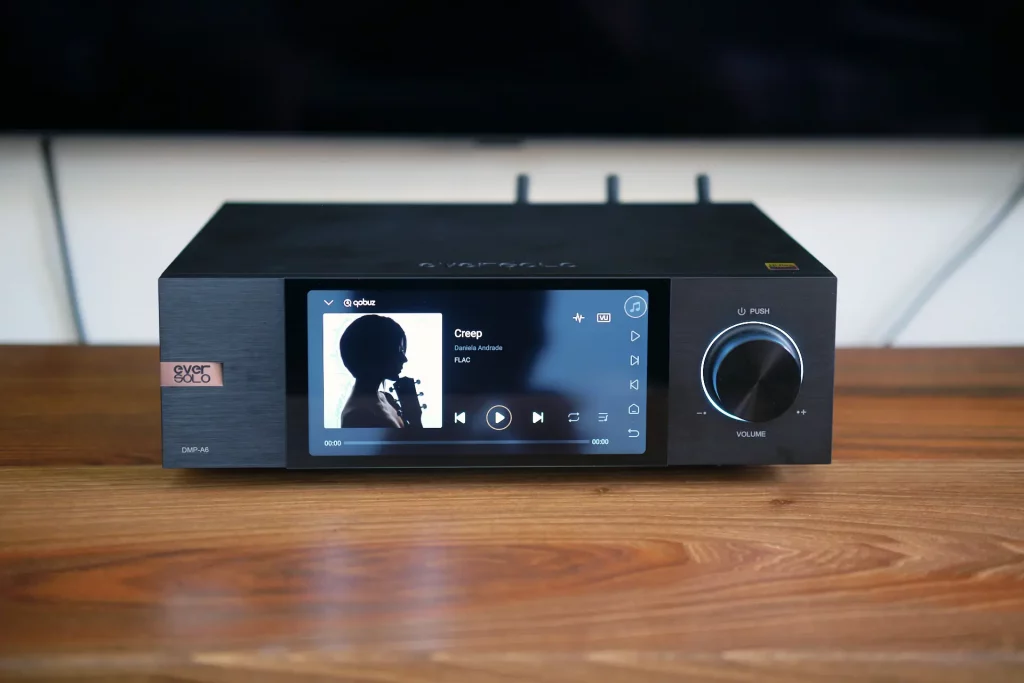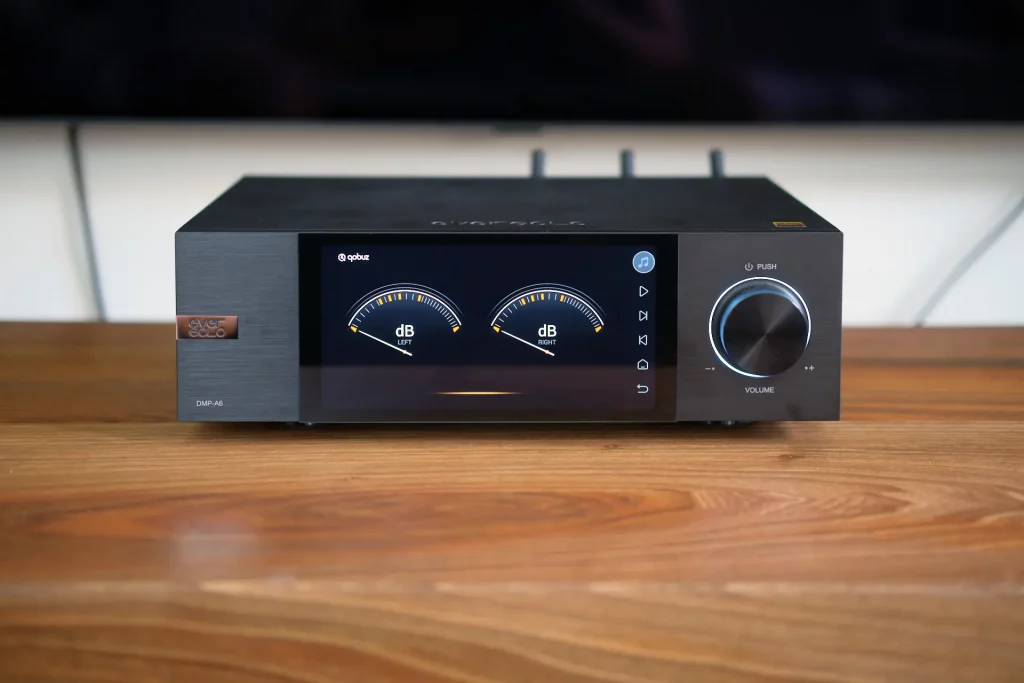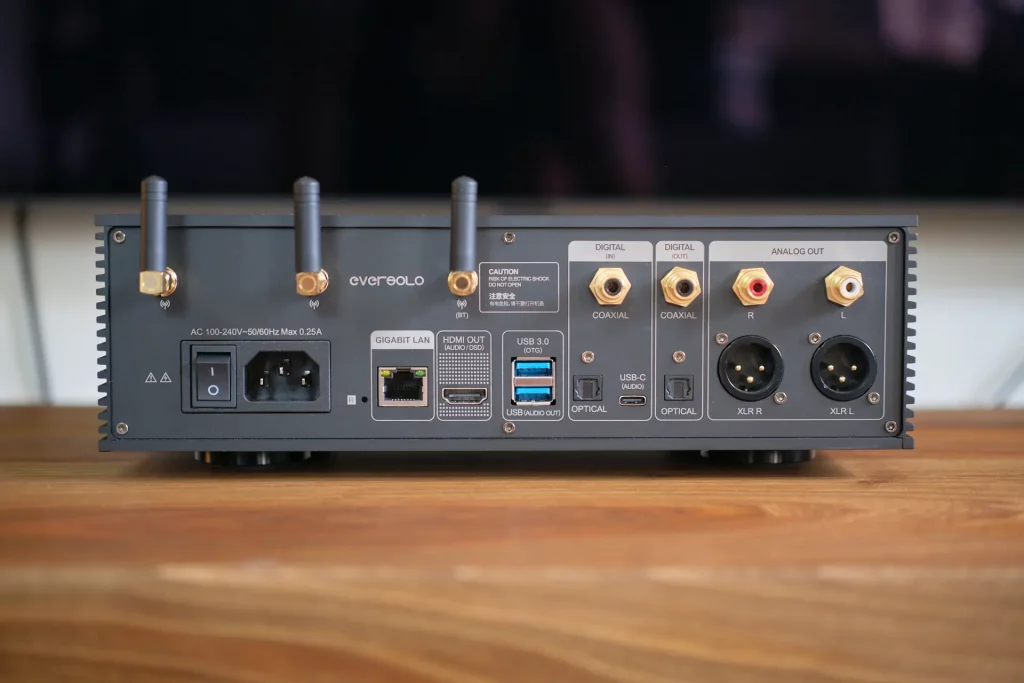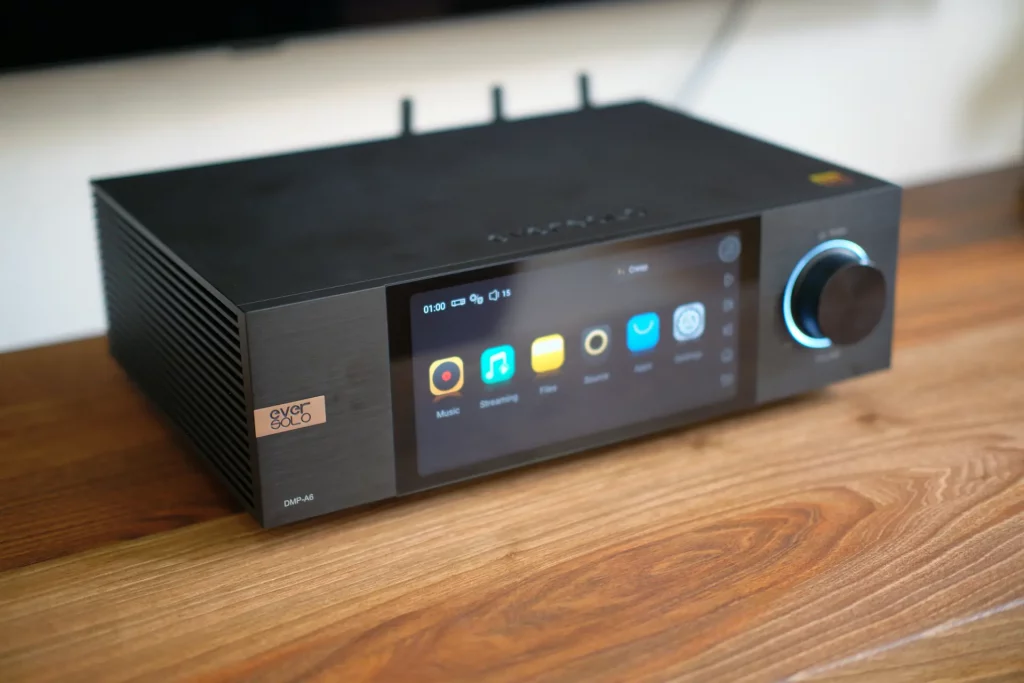A not long time ago I reviewed Eversolo DAC-Z8, a beautifully built and finished DAC that sounded very good too, but DMP-A6 is not just another DAC – it’s a fully loaded digital streamer with a DAC as one of its functions. Now fasten your seatbelts because we’re in for a ride.
Build and Connectivity
Eversolo DMP-A6 looks even better in real life than it does in pictures. Thick aluminum and a high-quality finish make it feel like a true premium product. Clean and sharp esthetics only add to it. One such detail is tempered glass covering LCD, that stretches from top to bottom of the front panel. The big touchscreen can be used to browse menus, and while music is playing it can be filled with usual information or one of four different VU meters that make this Streamer look really sweet in my humble opinion. Just take a look at it.


On the left side of the back panel, we can see an AC power inlet, meaning that the power supply is located inside the unit. Eversolo claims it’s a low ripple power supply but doesn’t talk much about its type. I’m making an educated guess here that we’re talking about a good-quality switching mode power supply. The selection of digital inputs is rich with a USB port C type, coaxial, and optical. There’s Bluetooth connectivity onboard too. But you can connect DMP-A6 to your home network using either Wi-Fi or LAN cable. There’s also one OTG USB 3.0 port, and lastly hidden at the bottom of the device is a slot for the SSD drive for locally stored files. Up to 4 TB sizes are supported.
As for the outputs, we have both digital and analog ones. Starting with the digital outs – there’s a coaxial, optical, USB, and HDMI. As for the analog section, a pair of single-ended RCAs and a pair of balanced XLRs are present. Both of these can be used as variable outputs so you can connect this DAC directly to a power amp and use its internal signal attenuation to control the volume level.

Software
Let’s start with the operating system loaded on the device itself. The OS is based on the Android system but adapted for the needs of an audio streamer. It works well and offers a rich set of options that will let you tailor how the device looks and feels. You don’t like the LED around the knob? No problem, you can dim it or completely turn it off. It’s the same with the display. If you want to see the cover of the album and currently playing track info, you can, but you can also use one of the four VU meters as I mentioned before.
The physical remote is not part of this package but you do get a very good control app instead, that’s available on both Play Store and Apple Store. It boasts clean looks, nice aesthetics, and well-arranged options. From the app, you can access your library, as well as both Tidal and Qobuz streaming services. Since I use both of these, I can say that the user interface looks great but some functions are missing. For example, the track radio function on Tidal is simply not there. The native player also leaves something to be desired when it comes to how it handles playlists. For example, you can only play one whole playlist that’s saved on these services… if you try to queue one song from another list only – that option doesn’t exist – you can only switch to that other playlist altogether. At first, even the option to rearrange song order in the queue didn’t exist. Luckily, that option arrived quickly through one of the updates, but it still doesn’t always work (I rearrange the songs’ order but the player keeps following the original playlist ignoring my edited queue). So yes, the native player in the control app can be annoying as it lacks some basic list editing functionalities that more mature Streaming OS-es have.
Luckily, you’re not bound to the native app as Eversolo DMP-A6 supports UPnP, Airplay, Tidal Connect, and Spotify Connect… so you can use any of the third-party apps supporting these connection protocols. I tried the Bubble UPnP app for UPnP and the official Tidal app for Tidal Connect. Everything worked great.
Sound (Digital Outputs)
If you’re thinking that the digital can’t possibly influence the sound quality of the HiFi system feel free to skip this section. Without getting into how and why I stand firmly on the side that says otherwise. Digital source does make a difference and in a resolving system, it’s not a negligible one either.
I hooked it up to several different DACs including Gustard R26 and my own DIY Tube DAC that’s similar to Lampizator designs. The resulting sound fidelity was really good. Music streamed from DMP-A6 sounds considerably better than if it would be played directly from my general-purpose PC. Every tone is audibly cleaner and more focused, while the space between individual tones is more obvious. The background is darker too and the sense of soundstage depth is much more pronounced. Spend some time listening to the music through DMP-A6 and then go back to the PC, and you’ll probably feel that every note just got swollen to some extent. Bassline feels slower and more bloated, while all instruments sound more diffused and less defined. Further listening reveals that after tone is much more easily observed over the Mercury. Notes such as guitar string pluck linger longer and you hear them decay slowly and more gradually. Reverbs and spatial cues are recovered with ease, and when combined with the background darkness this creates a very convincing soundstage.
Most of the last paragraph was simply copied from my Pi2Design Mercury review because that’s simply how a good digital audio streamer sounds compared to a PC. But a much bigger challenge is how it sounds compared to other capable audio streamers. So let’s talk about it.
Comparisons (Digital Outputs)
Pi2Design Mercury is a very capable digital audio streamer with roughly the same price tag. Its selection of inputs and outputs is different, and the most noticeable difference is that Mercury doesn’t include any analog outs, so an external DAC is a must. On a positive note, it does include I2S over HDMI connection. Mercury is based on the Raspberry Pi platform and as such it can be loaded with several different operating systems such as Volumio, RoPieee, Mo0de, etc. The set of available software features and user interface will mostly depend on this choice.
Now talking bout the build, there is no competition here to be perfectly honest. Mercury, especially the V1 model that I have, looks like a do-it-yourself effort compared to the beautifully finished and premium-looking DMP-A6.


But what about the sound you ask? Well, I first started using Eversolo DMP-A6 by connecting to it over UPnP protocol, using the Bubble UPnP app just like I always do with R-Pi based streamers. The difference was very subtle but DMP-A6 edged Mercury by a small margin. It sounded just a tad clearer and cleaner with micro details, but the overall level of detail retrieval, dynamics, layering, and soundstaging was comparable. I was already happy with the result since Mercury is a really great streamer already and it was backed by Allo Shanti linear power supply that increases the overall level of clarity compared to the factory-supplied SMPS.
But the surprise came once I switched to the native Eversolo app on my phone instead of using this third-party UPnP solution. I was quite puzzled to hear that soundstage inflated in all directions. Layering was even finer, and overall sound appeared to be even cleaner, but also fuller. The change was fully positive and switching to a native app lifted the performance level to another level. At this point, Pi2Design Mercury was simply outperformed.
iFi Zen Stream and Pi2Design Pi2AES are both roughly on the same level as Mercury regarding sound fidelity. Because of that, I won’t repeat all of the conclusions again, feel free to copy-paste them here too. That said, I still find iFi Zen Stream to be a well-built, well-priced, and great-sounding budget streaming solution. Unfortunately, it stays finicky since iFi didn’t do much in terms of updating its software since its release.
Bluesound Node (2021) is slightly more affordable and once again offers a slightly different set of features and connections. You can read the spec sheet I’m sure, so let’s move to their sound fidelity over digital outputs. Node sounds noticeably less clean and two-dimensional. I’ll be very simple here – Bluesound Node 2021 is not a match for Everso. DMP-A6 is simply a tier or two above the capability of Node 2021. Adding a good power supply to Node 2021 will improve things to some extent but not enough to bridge this kind of gap.
Sound fidelity aside, BlueOS is a much more mature system with a noticeably better native audio player better management options, and richer streaming service support. So if the overall comfort of use is what you’re looking for, Node is still one of the best options out there.
Innuos Pulse Mini costs roughly the same and offers roughly similar functionalities. You can check those differences yourself so I’ll focus on the sound difference. Regarding tonality, Pulse Mini sounds slightly brighter and leaner. DMP-A6 is more full-bodied and slightly darker up top. DMP-A6 also has a slightly deeper soundstage with a darker background and that to my ears makes it a better-sounding streamer in this duel.
Sound (Analog Outputs)
Eversolo’s internal DAC section is based on two Sabre ES9038Q2M chips. Even though the used DAC chip is not the only thing influencing the sound on the output, well-trained ears will easily catch on to some typical Sabre traits here. Simply put, DMP-A6 sounds clean and precise. To elaborate it a bit more, the notes are super clean, with crisp and well-defined edges. It doesn’t matter what type of instruments are playing, DMP-A6 will present them with firm focus and outline them very clearly. Tone separation is also great, and everything is drawn over a dark background, which only adds to the whole sensation of clarity. Luckily, this DAC is well-balanced and with enough smoothness in its presentation to never overstep into excessive sharpness or annoying brightness.
A nimble and well-controlled bassline never oversteps its boundaries to lend some sort of warmth or thickness to the midrange. This goes hand in hand with the overall sound signature that boasts good speed and timing and will never sound too slow or sluggish no matter the material being thrown at it. It’s a DAC for those looking for a clean and tidy presentation with plenty of speed and pinpoint precision.
Soundstaging is once again in line with what I came to expect from a decent Sabre DAC in this price category. Everything is decently separated and instruments do have a space to breathe. That said, the absolute limits of the soundstage are OK but will not rival the best AK DAC models in this category, let alone R2R designs.
Comparisons (Analog Outputs)
Eversolo DAC-Z8 is a standalone DAC and headphone amp without streaming functionality. Now, I didn’t have Z8 with me for a direct comparison, but the way I remember it, we’re talking about the exact same sound signature. Some of you might have noticed that most of the previous section is the same as in the DAC-Z8 review, it’s simply because they both left the exact same impression. Simply choose if you need a streaming DAC or a DAC with a headphone amplifier.
Bluesound Node (2021) is slightly more affordable and once again offers a slightly different set of features like having a SubWoofer out but lacking the balanced analog outputs that Eversolo has. But moving to their sound fidelity, Node sounds noticeably less clean and two-dimensional. I’ll be very simple here – Bluesound Node 2021 is not a match for Eversolo DMP-A6 is simply a tier or two above the capability of Node 2021. But just like it was true in the previous digital section, Node’s BlueOS is still better software, with richer functionality, and simply more comfortable to use.
Innuos Pulse Mini on its analog outs actually fights back very well. Its brighter tonality is still here, making for a slightly airer sound on the analog outs. Eversolo DMP-A6 might sound cleaner in the midrange, but Pulse Mini offers a slightly richer inner tone texture, and to my ears that feels ever so slightly more natural and pleasant to listen to. On the other hand, DMP-A6 is slightly more energetic and more focused, especially if balanced outputs are used (Pulse Mini doesn’t have balanced outs). So this comparison will boil down to personal preferences and system matching really, but I have to say that I slightly preferred that natural midrange and tone texture rendition of the Innous Pulse Mini.
Conclusion
Let’s try to bind this review together in a coherent conclusion. Eversolo DMP-A6 offers a premium build and premium sound over its digital outputs. Those are so good that even pricier streamers will struggle to match it. The analog section is very competent too. Software on the other hand is more of a two-fold experience. On one hand, it’s smooth, visually polished, and reliable. On the other, the native player is pretty barebone and lacks some basic playlist management options that we came to expect. I truly hope that Eversolo will keep updating it as they already did to some degree.
All in all, we’re talking about an exceptional value here. After finishing the review process, I kept using DMP-A6 as a digital streamer that’s feeding my external tube DAC and I never even thought of removing it from that duty. Easy recommendation.
| EVERSOLO DMP-A6 – CHARACTERISTICS |
|
Solid aluminium alloy chassis, brushed panel. |







http://forum.zidoo.tv/index.php?threads/tidal-connect-sound-quality.95860/
I started this thread, since I also find the native app sound better than using Tidal Connect, which I always thought was “bit perfect”, but apparently not.
It’s a bit of a mystery, that not more people are unsatisfied, with Tidal Connect apparently doing something to the audio quality.
I have experienced this with a Bluesound Node 2i as well, that sound better when using Roon as opposed to Tidal Connect.
Could this be a subject for a video to spark Tidal to tell, what’s is going on with the implementation on their connect feature, and how it somehow affects the audio quality.
Great review, and the DMP-A6 appears as a truly top streamer. My only observation is that it features the now obsolete and irrelevant MQA, and though I understand it has multichannel support, no mention of Atmos that now seems to be unstoppable. Hopefully Ever Solo can resolve the issue with a downloadable Update !?!
I have a Gustard R26. Having tried it with the Dmp-A6, could you explain better whether or not you definitely recommend using it as a streamer together with the R26? Or do you suggest I go elsewhere?
Thank you.
Which digital output do you prefer when you use the A6 as a digital transport. The spdif COAX or the USB and why?
I didn’t notice that either out is clearly superior to the other. In cases like this the more important question is if the external DAC that’s connected prefers Coax or USB conection. Just try both in your setup and with cables you have and you’ll find out.
The touchscreen is one of the selling points but it can only be set on between 5 minutes and max 2 hours and then the screen goes off.
Hi – a little suggestion only: Perhaps you should try to review a REAL high-end streaming bridge, such as for instance Auralic Aries G2.1 (or the new G2.2)? Although the Eversolo may be good for its price point, I expect there to be a huge performance leap, not even a comparison. As an added bonus, Auralic’s Lightning operating system is very mature, with full DSP functionality. It is also possible to get a 2nd-hand Aries G1 for just a bit more than a DMP-A6, and also that one should perform on a considerably higher level with its dual linear PSU’s, dual femto clocks etc.
Just an idea from Norway 🙂
Kind regards,
Morgan
Hello,
cf https://www.audiosciencereview.com/forum/index.php?threads/eversolo-dmp-a6-streamer-review.44198
Sincerely.